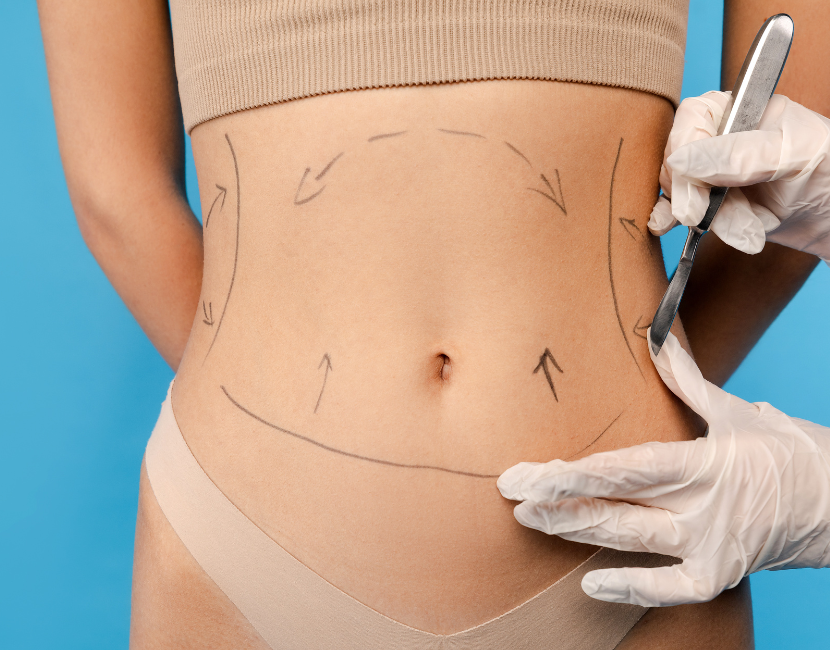Learn about the types of tummy tuck incisions
Knowing the different types of incisions in a tummy tuck helps to understand how Dr. Garcia adapts each technique to the patient's anatomy and objectives. Each line is precisely planned to achieve natural, harmonious and discreetly scarred results.

Una Abdominoplasty, also known as a tummy tuck, is a cosmetic surgery that removes excess skin and fat from the abdomen and improves muscle tone. The type of incision largely determines the final appearance, extent of the scar, and aesthetic results. Understanding the different options helps you choose the most appropriate approach for each patient and their goals.
The most common techniques include mini tummy tuck, full tummy tuck and extended tummy tuck. Each one uses incisions of a different length and location to adapt to the degree of sagging or excess tissue. For example, a complete procedure may include a horizontal incision over the pubis and another around the navel.
Types of Abdominoplasty Incisions
The incisions determine the extent of the surgery, the amount of skin removed, and the location of the scar. Each type seeks to balance aesthetic results with safe recovery and a scar that is as discreet as possible.
Standard horizontal incision
La full tummy tuck uses a low horizontal incision, which extends between the hips. This approach allows skin and fat to be removed from the lower abdomen and tightens the abdominal muscles.
The navel is repositioned to maintain a natural appearance, and the length of the incision depends on the excess skin and the patient's anatomy.
This type of Tummy Tuck It is the most common and offers a marked improvement in abdominal firmness. The horizontal incision favors anatomical and safe results.
Mini-abdominoplasty incision
La mini abdominoplasty uses a short incision, similar to a C-section. It is recommended when excess skin is located only below the navel. It does not require repositioning the navel, shortening recovery and reducing scarring.
Ideal for thin patients with mild sagging, this type of tummy tuck leaves a discreet, low and easily concealed scar.
Extended incision
La extended tummy tuck widen the incision to the flanks or lower back. It is ideal for patients who have lost significant weight, as it allows you to remove excess skin on the sides and define the waist.
In combined procedures, the extended incision offers a more complete remodeling of the trunk with well-concealed scars.
Fleur-de-lis incision
La Abdominoplasty in Fleur-de-Lis combines a low horizontal incision with a vertical incision in the center of the abdomen. This “inverted T” shape removes excess skin in two directions, suitable for patients with massive weight loss.
Although the vertical scar may be visible, the result is a much flatter and more defined abdomen. The precision of the closure, especially under the technique of Dr. García Rodríguez, helps to reduce tension and optimize healing.
How to choose the right type of incision?
The choice of the type of incision depends on the patient's anatomy, the amount of excess skin, and aesthetic goals. A detailed analysis and a personalized surgical plan are essential to achieve natural and proportional results.
El Dr. Antonio Garcia Rodriguez evaluates abdominal structure, skin elasticity and previous scarring to determine the most suitable technique. His approach combines anatomical knowledge with an aesthetic sense that prioritizes body harmony and the minimum visibility of scars.
Anatomical factors and aesthetic objectives
Every abdomen is different. The shape, elasticity and fat distribution determine the extent and position of the incision. In some cases, a “bikini” incision is sufficient, while others require a larger approach to remove skin folds.
Evaluation of excess skin and oil
Before surgery, the amount of tissue to be removed is analyzed using physical examination and clinical photographs. This step defines whether the patient requires a mini or a full tummy tuck. Precise planning avoids tension and improves final symmetry.
Scars, Recovery and Results
Abdominoplasty leaves scars that vary depending on the technique and aftercare. With proper care, they become flatter and clearer over time, achieving an aesthetic and functional result.
Location and visibility of scars
Most tummy tucks leave a low scar, easily covered by underwear or a swimsuit. The use of healing creams, silicone sheets and sun protection accelerates your improvement.
Recovery and care
El recovery time depends on the type of technique. Mini-abdominoplasty requires fewer days of rest, while a full one may need four to six weeks. Wearing a compression bandage, maintaining hydration and following medical instructions are key to successful healing.
FAQs
What types of incisions are there in a tummy tuck?
The most common are low horizontal incision, mini-tummy tuck, extended incision, and inverted T-tummy tuck. Each one is adapted to the degree of sagging and the desired result.
How do you choose the ideal technique?
The surgeon evaluates the amount of skin and fat, the position of the navel, and the patient's expectations. At the initial consultation, Dr. Garcia Rodriguez explains the options for Tummy Tuck Incision Types safer on a case-by-case basis.
What does the scar look like after a tummy tuck?
The scar is placed as low as possible so that it can be easily hidden. With proper care, it clears and softens over time.
When are the final results seen?
The results begin to be noticed after the first few weeks, although the definitive appearance is consolidated between three and six months later, when the inflammation subsides completely.
Why choose Dr. Antonio García Rodríguez?
Dr. García Rodríguez combines advanced techniques in tummy tuck with an aesthetic approach that prioritizes the patient's naturalness and well-being. His extensive experience in body contouring surgery allows him to offer safe, proportionate results in accordance with the figure of each person.



